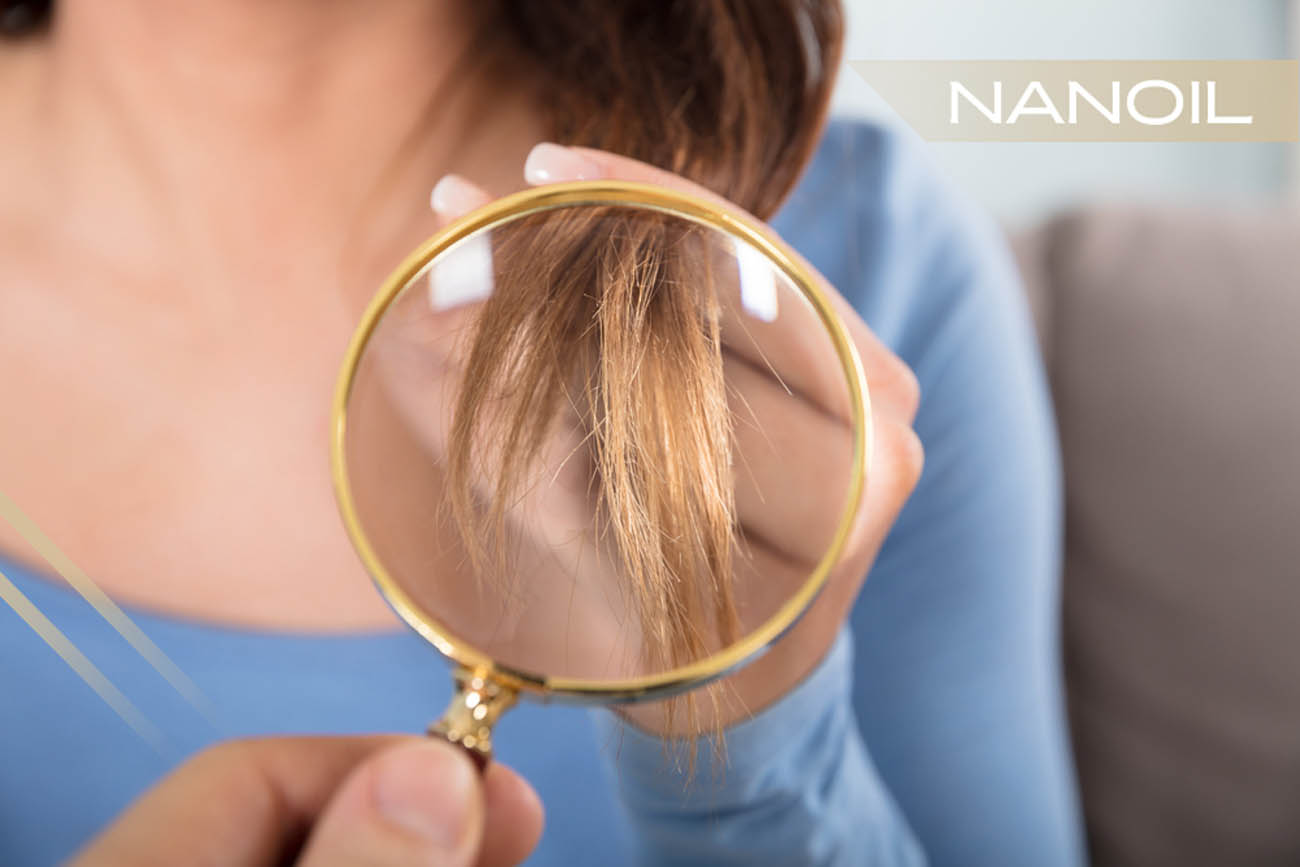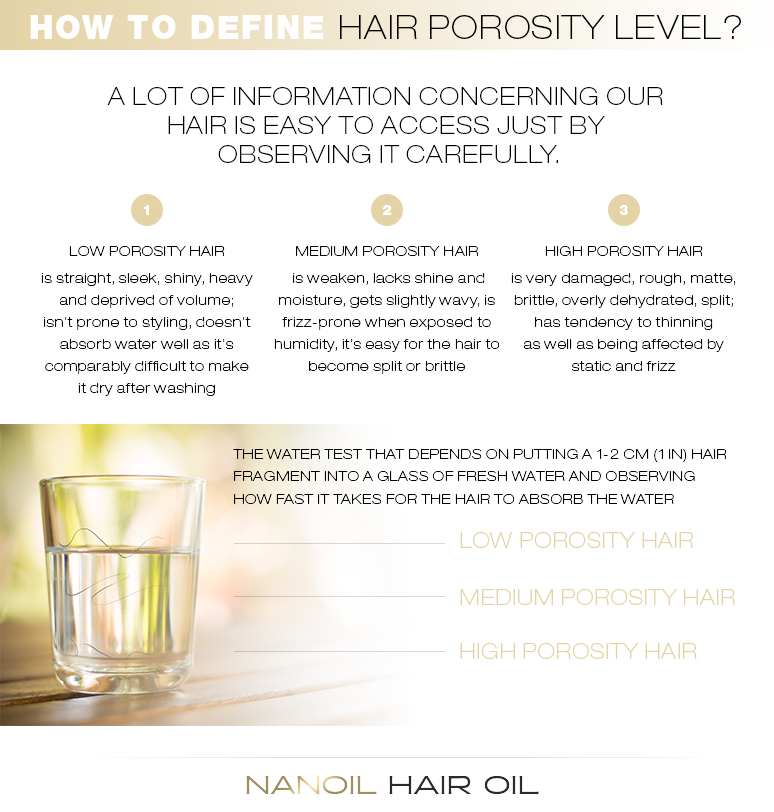- NANOIL Products
- Oils
- Face serums
- Hair masks
- Shampoos
- Hair conditioners
- Hair styling
- Hair Porosity Test
- Blog
- Contact

If it wasn't for the hair structure and the knowledge concerning its needs, hair oil treatment wouldn’t be so successful. The key to find the perfect hair oil, the one which will fulfil our hair care expectations, is defining the hair porosity first. Do you know how porous your hair is? You must take a peek at this article to find out more about this subject.
The most effective hair care is the one that answers our hair needs. The strands may by affected by various problems and these are directly connected with the changes that occur on the hair’s outer structure. The way the hair is built has a major influence upon the changes the strands undergo. Naturally, the damaging factors we tend to continuously expose our hair to have the impact on the state of our strands as well.
Although it's not that important how hair is built when we treat the strands with a shampoo or a light conditioner only, the effective hair oil treatment requires the error-free oil selection. Not every oil serves all hair types. Curly hair care should differ from greasy hair care. Which hair oil to choose? The answer is the hair.
Our scalp features approximately 100 thousand of follicles. Each follicle is a home to a hair bulb although not every hair bulb grows a hair. The fun fact is that there are 180-350 hairs per one square centimetre of the skin.
In general, a hair is divided into two parts: a root and a shaft. This first part is located inside dermis, in its subcutaneous layer. The hair shaft is the visible part which, obviously, is located above the skin. If we were to enumerate the layers the hair shaft is built from, these would be medulla, cortex and cuticle. The last two layers are made of keratin therefore the role of this substance is tremendous when it comes to hair care.
In the case of cortex, it is composed of strong vertical keratin fibres which surround hair concentrically and are responsible for its flexibility, for example. Keratin is a protein of exceptionally high resistance to damages, which doesn't mean that hair is indestructible. Apart from this essential building block, the coat features the optimal amount of water which should remain at the same layer to preserve hair health. Also, this coat features melanin grains, which is a pigment that gifts hair with colour.
The keratin layer of the hair is located as the most externally placed one. It's made of callous cells the shape of which can be described as scale-like. Usually these are arranged in 5-10 layers that surround hair like a shield made of roof tiles. They play a protective role against various kinds of damaging factors. The hair cuticles are fixed one to another as well as to the inner layers of a hair shaft thanks to oily substances. As a consequence, supplying strands with EFA (Essential Fatty Acids) is regarded as absolutely crucial.
Apart from the cuticles, the ones which create an armour, the hair is protected by a wax-and-oily layer, also known as sebum. It's secreted by sebaceous glands to follicles where it gets its outlet from, maintaining the keratin shield and delivering hydration to hair. It’s also worth mentioning that in great extent the human sebum consists of free fatty acids.

What's hair porosity? It's one of anatomic features of our hair. It defines the position which the above-mentioned hair cuticles take towards medulla. Interestingly, hair cuticles are able to change their position. The more open the cuticles are, the worse it is for us. Once open widely, the sensitive medulla remains unprotected and this results in fast hair deterioration. This is the very reason why hair porosity is defined as the angle at which hair cuticles are raised, or which is more often encountered, as the level of hair damage.
We distinguish three hair porosities:
It's not a permanent feature of hair although in some cases we can establish some relations like, for example, the fact that curly hair is usually highly porous. In any other cases it is us who determine the porosity level of our hair. Actually, all you have to do is take care of the hair in the right way so as to make it healthy and help it preserve its low porosity. The hair porosity increases by being under the influence of damaging factors such as the scorching sun, lightening up procedure, dyeing, thermal styling, etc.
Interestingly, our hair can have various porosity levels depending on the hair shaft's part we take under examination - the closer to the head, the lower the hair porosity gets. The high porosity is typical for the hair ends that are exposed to splitting and lose water fast.
There are various ways to define hair porosity. How to find out what the structure of our hair is? The most precise answer will be provided by visiting either the trichologist’s office or the professional hairdresser's salon, where you can undergo microscope examination. When in close-up, it's easier to define the arrangement of hair cuticles in relation to the medulla. However, if we don't have the possibility to visit a trichologist, you can define the hair porosity on our own.
A lot of information concerning our hair is easy to access just by observing it carefully. To demonstrate,
Hair porosity test is a fairly helpful tool while defining the type of hair. All you have to do is answer a few simple questions concerning, for example, how long your hair needs to get dry, its general state, condition of the hair ends, styling difficulties, etc. Once the test is over, we are provided with an answer that indicates the particular hair porosity level. With a high probability the algorithm is able to define the type of hair precisely.
How to check the hair porosity at home? Many bloggers present three, less known methods which aren't such trustworthy and can cause even greater difficulties in defining hair porosity. These methods include:
HAIR POROSITY AND THE HAIR OIL TREATEMENT
What's the point in knowing your hair porosity type? As it was mentioned at the beginning of this article, hair porosity is the key information. The exact knowledge concerning the state of our hair greatly contributes to proper hair care and the choice of oils which are to restore health to our strands. One has to be taken for granted, a mismatched oil is the quickest way to deteriorate hair looks.
Hair favours various methods of care as long as they match its porosity. For example, low porosity hair is fine when the oil treatment lasts long, although it's easy to overburden the hair. High porosity hair, in turn, requires short yet deep oil treatment or acid hair washes to help the cuticles become closed. Both hair care and the oils have to go hand in hand with the hair structure. What hair oil is the best one?
Depending on the hair porosity, hair oils should vary because:
Leave your email address and we ll notify you when the product is back in stock.
Comments: #0